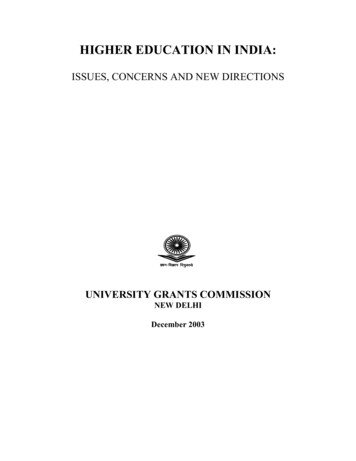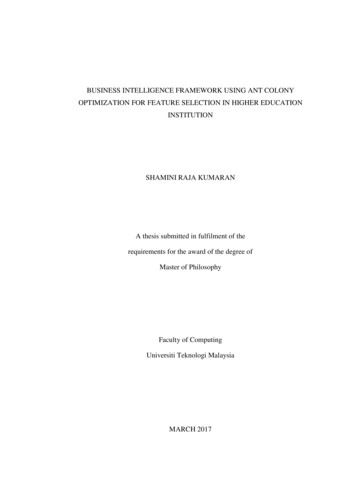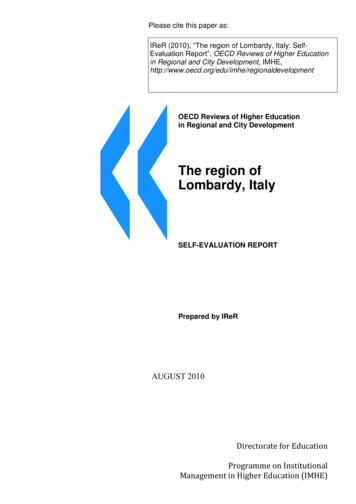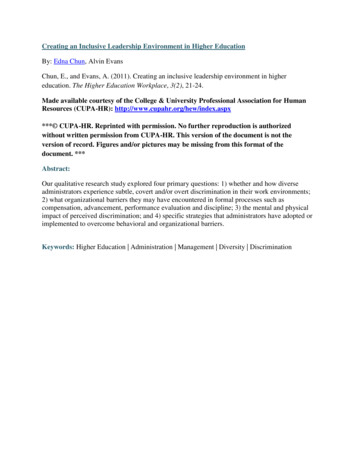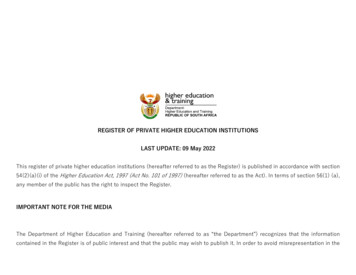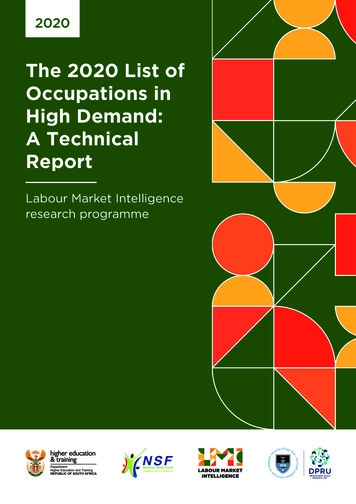
Transcription
2020The 2020 List ofOccupations inHigh Demand:A TechnicalReportLabour Market Intelligenceresearch programmeNSFNational Skills FundFUNDING TO SKILL OUR NATION
2020The 2020 List ofOccupations inHigh Demand:A TechnicalReportLabour Market Intelligenceresearch programmeMichele Capazario, Fouché Venter (DNA Economics)
AcknowledgementsThe authors would like to thank everyone who assisted with and contributed tothe creation of the List of Occupations in High Demand for 2020. We extend ourgratitude to the Department of Higher Education and Training (DHET) and theDevelopment Policy Research Unit (DPRU) for their guidance and input throughoutthe process. In particular, the contributions of Ms Mamphokhu Khuluvhe (DHET),Ms Sybil Chabane (DHET), Dr Hersheela Narsee (independent consultant), Prof.Mike Rogan (Rhodes University), and Prof. Haroon Bhorat (UCT and DPRU) wereinvaluable to the process of developing this list. Lastly, we would like to thank theSouth African Qualifications Authority (SAQA), under the leadership of Dr JulieReddy, for assisting with mapping qualifications to each of the occupations.AuthorsMichele Capazario, Fouché Venter (DNA Economics)Suggested citationDNA Economics (2020). The 2020 List of Occupations in High Demand: A TechnicalReport. Produced for the Department of Higher Education and Training (DHET) aspart of its Labour Market Intelligence (LMI) research programme.The 2020 List of Occupations in High Demand: A Technical Report
ContentsList of figures5List of tables6Acronyms and abbreviations7PART 1:INTRODUCTION TO THE LIST OF OCCUPATIONS INHIGH DEMAND8PART 2:ORGANISING FRAMEWORK FOR OCCUPATIONS10PART 3:THEORETICAL FOUNDATION13PART 4:METHODOLOGY164.1 Quantitative methodology174.2 Qualitative methodology204.3 Validation224.3.1Why validation is required224.3.2Validation234.3.3The impact of the COVID-19 pandemic24PART 5:ANALYSIS OF RESULTS325.1 Quantitative analysis335.2 Qualitative analysis405.2.1Transversal occupational demand405.2.2Moderate occupational demand425.2.3 Sector-specific demand445.2.445List of Priority Occupations (LPO) and Critical Skills List (CSL)5.2.5 Summary list of occupations5.3 Validation51595.3.1 Stakeholder inputs605.3.2 Sensible, skilled, and in shortage72
PART 6:PRESENTING THE 2020 LIST OF OIHD81PART 7:CONCLUSION AND WAY FORWARD96APPENDIX 1:REVIEW OF THE OECD AND MAC METHODOLOGIESFROM THE 2018 LIST OF OIHD98APPENDIX 2:FOUR-DIGIT LIST OF OIHD ROBUSTNESS CHECKS102APPENDIX 3:LIST OF STAKEHOLDER MEETINGS, SEMI-STRUCTUREDINTERVIEWS, AND GAZETTE COMMENTS122APPENDIX 4:FIELDS OF STUDY AND SPECIALISATION INCLUDEDUNDER UNIVERSITY LECTURER124PART 8:BIBLIOGRAPHY4The 2020 List of Occupations in High Demand: A Technical Report127
List of figuresFigure 1:The concept of an occupation being in high demandFigure 2:Number of classifications in the OFO11Figure 3:Relationship between OFO major categories and NQF level12Figure 4:Literature synopsis159Figure 5: High-level view of the list of OIHD methodology17Figure 6: Inclusion/exclusion criteria for qualitative analysis21Figure 7:Five-step qualitative methodology approach21Figure 8:Distribution of unit groups in the 2018 four-digit list of OIHD compared to distributionof unit groups in the 2020 four-digit list of OIHD, broken down by OFO major category37Decomposition of demand signals38Figure 9:Figure 10: Decomposition of demand signals (excluding strategic priority/literature-based signal)39Figure 11: Distributional breakdown of occupations in transversal demand in South Africa41Figure 12: Distributional breakdown of occupations in moderate demand in South Africa43Figure 13: Distributional breakdown of occupations in sector-specific demand in South Africa45Figure A 1: Unit group overlap when using PCA or equal weighting methodologies107Figure A 2: Overlap summary between equally weighted unit group list of OIHD and reweightedunit group list of OIHDs109List of figures5
List of tablesTable 1:Meaning of 1st digit of OFO code11Table 2: Historical overview of the list of OIHD14Table 3:18Quantitative methodology indicator list and descriptionTable 4: Impact of COVID-19 at a sectoral level in South Africa25Table 5: Potential sector-level impact of COVID-19 in South Africa30Table 6:33List of OIHD at four-digit level (equally weighted within dimensions, ordered by OFO code)Table 7: Occupations that are transversally demanded40Table 8: Occupations that are moderately demanded42Table 9: Occupations in sector-specific demand44Table 10: Occupations included in the list of OIHD based on the CSL and LPO findings46Table 11: List of OIHD prior to validation51Table 12: Occupations included from semi-structured interviews60Table 13: Occupations excluded from the list of OIHD by the South African Artisans Movement61Table 14: Occupations included in the list of OIHD based on BPESA submissions62Table 15: Student headcount per FTE staff member across CESM classification in South Africa63Table 16: Occupations included in the list of OIHD based on the ETDP SETA submissions64Table 17: Occupations included in the list of OIHD based on the W&R SETA submissions64Table 18: Occupations included in the list of OIHD based on the SBIDZ submissions65Table 19: Occupations included in the list of OIHD based on the Forest-Based Industry Board submissions 65Table 20: Occupations included in the list of OIHD based on the CTFL industry representative submissions 666Table 21: Occupations included in the list of OIHD based on the NAACAM submissions66Table 22: Occupations included in the list of OIHD based on the SABMEO submissions67Table 23: Occupations included in the list of OIHD based on the SAIBA submissions67Table 24: Occupations included in the list of OIHD based on the NBC CMI submissions68Table 25: Occupations included in the list of OIHD based on the DoT submissions68Table 26: Occupations included in the list of OIHD based on the DOT submissions69Table 27: Other responses to the request for public comment that provided valuable information70Table 28: List of occupations being scrutinised under the 3S methodology73Table 29: Finalised list of OIHD83Table A 1: Framework for the OECD and MAC methodologies101Table A 2: Overlap between PCA and equal weighting four-digit unit group list of OIHD102Table A 3: Weights attached to dimensions and indicators when reweighting to remove potential biasestowards an indicator/dimension108Table A 4: List of unit groups appearing in reweighted list of OIHD110Table A 5: Weighting matrix for including direct measure for shortage in the unit group list of OIHDquantitative list116Table A 6: Overlap between unit groups in equally weighted list of OIHD vis-à-vis unit groups inshortage-reweighted list of OIHD116Table A 7: List of stakeholders contacted by DNA Economics and the DHET, and modalities throughwhich communication was made122The 2020 List of Occupations in High Demand: A Technical Report
Acronyms and abbreviations3SSensible, skilled, and in shortageMACMigration Advisory CouncilBPESABusiness Processes Enabling South AfricaMERCATHSCulture, arts, tourism, hospitality, and sportsManufacturing, engineering, and relatedservicesCESMClassification of educational subject matterCFECall for evidenceCHIETAChemical Industries Education and TrainingAuthorityCHWCommunity healthcare workerCJCareer JunctionCOVID-19 Coronavirus disease 2019CSIRCouncil for Scientific and Industrial ResearchCSLCritical Skills ListCTFLClothing, textiles, footwear, and leatherDELDepartment of Employment and LabourDHETDepartment of Higher Education andTrainingDOJDepartment of JusticeDoTDepartment of TourismDOTDepartment of TransportationESSAEmployment Services South AfricaETDPEducation, training, and developmentpracticesEWEnergy and waterHPCSANAACAM National Association of AutomotiveComponent and Allied ManufacturersNDOHNational Department of HealthNGPNew growth pathNHLSNational Health Laboratory ServiceNQFNational Qualifications FrameworkOCJOffice of Chief JusticeOECDOrganisation for Economic Co-Operationand DevelopmentOFOOrganising Framework for OccupationsOIHDOccupations in high demandPCAPrincipal component analysisPIVOTAL Professional, vocational, technical, andacademic learningPSETPost-school education and trainingPsySSAPsychological Society of South AfricaQLFSQuarterly Labour Force SurveySABMEO South African Blanket ManufacturersEmployers OrganisationSACAPSouth African Council for ArchitecturalProfessionHealth Professionals Council of South AfricaSAFREASouth African Freelance AssociationHWHealth and welfareSAIBAICTInformation and communicationstechnologySouth African Institute for BusinessAccountantsSAIEESouth African Institute for Electronic EngineersSASSafety and securitySASASecurity Association of South AfricaSAVCSouth African Veterinary CouncilSBIDZSaldanha Bay Industrial Development ZoneSETASector Education and Training AuthoritySIPsStrategic integrated projectsSSISemi-structured interviewSSPSector skills planTETATransport Education and Training AuthorityW&RWholesale and retailIITPSAInstitute of Information TechnologyProfessionals of South AfricaIOBSAInstitute of Bankers of South AfricaIPAPIndustrial Policy Action PlanIPASAInternational Police Association of SouthAfricaIRMSAInstitute of Risk Management of South AfricaJIPSAJoint Initiative for Priority Skills AcquisitionJOIJob Opportunities IndexLMDSLabour Market Dynamics SurveyLPOList of Priority OccupationsAcronyms and abbreviations7
PART 1Introductionto the Listof Occupationsin High Demand
PART 1Understanding occupational dynamics and labour market requirements are vital to meeting thegoals of the National Development Plan (NDP), the New Growth Path (NGP), and the Industrial PolicyAction Plan (IPAP). The Department of Higher Education and Training (DHET) has an important role toplay in both identifying the key occupations that will support these policy initiatives and improvingthe responsiveness of the post-school education and training (PSET) system to the skills needs ofthe economy.The List of Occupations in High Demand (OIHD) (henceforth referred to as “the list of OIHD”) is one ofthe most important mechanisms through which the DHET fulfils this role. The primary purpose of thelist of OIHD is to inform planning in the PSET sector by: Signalling the need for the development of new qualifications; Acting as a signpost for enrolment planning (Reddy, Rogan, Mncwango, & Chabane, 2018); and Informing career guidance for learners and work-seekers.To fulfil this purpose, the list of OIHD consists of occupations that show relatively strong employmentgrowth or experience shortages in the labour market. More specifically, occupations are said to be inhigh demand if they fulfil the descriptions outlined in Figure 1 below:FIGURE 1: The concept of an occupation being in high demandAn occupation has shown relativelystrong signs of employment growthin the past, in the present, andpotentially in the future as well;An occupation has been identifiedas being in shortage (meaning thatthe demand for a skill/occupation ishigher than the supply of adequatelyskilled individuals turned out by thePSET system); orAn occupation is seen as noveland is expected to emerge in thenear future due to innovation andtechnological advancements oris brought about by governmentstrategic priority.Source: Reddy, Rogan, Mncwango, & Chabane (2018)It is through providing a clear understanding of the demand for skills and occupations that are not beingmet in South Africa that the list of OIHD acts as an integral component for holistically understandingSouth African labour market dynamics.Beyond presenting the list of OIHD, this technical report’s primary aim is to describe the approach takento identifying occupations that fulfil the definitions articulated in Figure 1. This report also seeks to clarifythe historical foundations for the list of OIHD by explaining its methodological evolution over time andby describing the international methodologies from which the list of OIHD methodology borrows. Thecurrent methodology will then be described, and an analysis of the results presented. First, however, itis important to explain South Africa’s Organising Framework for Occupations (OFO) as it represents anessential building block to understanding the methodology employed.Introduction to the List of Occupations in High Demand9
PART 2OrganisingFramework forOccupations
According to the DHET, the OFO is a classification framework that establishes “a common language fortalking about occupations”. The OFO:PART 2is a skill-based, coded classification system of occupations which is used by the DHET for“identifying, reporting and monitoring skills demand and supply” in the labour market. Itcaptures almost all occupations in the country and classifies them by skill level and skillspecialisation. (Reddy et al., 2018, p. 10)The framework consists of eight major groups, categorised primarily according to skill level andsecondarily according to area of specialisation. The eight major groups are presented in Table 1.TABLE 1: Meaning of 1st digit of OFO codeOFO CODE 1ST s and associate professionals4Clerical support workers5Service and sales workers6Skilled agricultural, forestry, fishery, craft, and related trades workers7Plant and machine operators and assemblers8Elementary occupationsEach of these major groups are then disaggregated into four levels, with each subsequent levelproviding more specific detail than its predecessor. As shown in Figure 2, the eight one-digit majorgroups together encapsulate the entire set of 1,510 six-digit occupations.FIGURE 2: Number of classifications in the OFO8major groups(1-digit)39 sub-major groups(2-digit)125 minor groups(3-digit)440 unit groups(4-digit)1,510 occupations(6-digit)Source: DHET (2019)Organising Framework for Occupations11
Occupations are, therefore, the lowest coded level of disaggregation.1 Each occupation is given a sixdigit code with each digit in the code referring to its respective grouping, as depicted in the pyramidabove. This can be most easily understood as follows:1st digit2nd digit3rd digit4th digitMajorSub-majorMinorUnits5th digit6th digitOccupationsThe eight major groups will be particularly interesting when analysing the composition of the list ofOIHD. The major group indicates the skill level and the broad area of specialisation. Figure 3 maps themajor groups to the National Qualifications Framework (NQF) levels. It illustrates that as the majorgroups move from 1 to 8, the NQF levels decrease.FIGURE 3: Relationship between OFO major categories and NQF levelNSDS (level of skillrequired for a givenNQF)NQFOFO MAJOR 6Technicians and associate professionals544567Clerical supportworkersService andsales workersSkilledagricultural,forestry, fishery,craft, and relatedtrade workersPlant andmachineoperators andassemblers3Entry218Elementary occupationsSource: DHET (2015)The importance of the relationship between OFO major categories and occupations presented in Figure3 will become apparent in subsequent sections of this report.112There are specialisations within the occupations in the OFO, but these are not coded.The 2020 List of Occupations in High Demand: A Technical Report
PART 3Theoreticalfoundation
The 2020 list of OIHD will be the list’s fourth iteration, the first having been published in 2014, followedby a new publication every two years thereafter. Over this period, the methodology has evolved as thelist has responded to the lessons learned from each previous publication.A report completed by DNA Economics in 2020 outlined the approaches followed for the previousiterations of the list, and highlights the development of the methodology over time:TABLE 2: Historical overview of the list of OIHDITERATIONOF THE LIST2014DEFININGCHARACTERISTICSA primarily qualitativeapproach based onthe review of strategicgovernment documents.BRIEF OVERVIEW OF THE METHODOLOGYUSED TO GENERATE THE LISTzzz20162018214Included quantitativeanalysis of data from theQuarterly Labour ForceSurvey (QLFS) and JobOpportunity Index (JOI) inaddition to documentaryreview.Included quantitativeforecasting ofoccupational growth.2Broader validation processwith private and publicsector stakeholders.zDeveloped amultidimensional index ofdemand.Included data from CareerJunction (CJ).2-stage approachconsisting of a bottomup quantitative methodand top-down qualitativemethod.zzzzzzVarious sources were used qualitatively, such as SectorEducation and Training Authority (SETA) professional,vocational, technical, and academic learning (PIVOTAL)lists, sector skills plans (SSPs), strategic integrated projects(SIPs), the Joint Initiative for Priority Skills Acquisition(JIPSA), and so forth.Given these sources, a points-based approach was used,with an occupation scored out of 100 (based on SETAidentification, appearance in the SIPs and the JIPSA, thenumber of associated vacancies, etc.).This created a list of occupations (at the six-digit level) thatwas then validated and added to by a broad set of privateand public sector participants.Data from the QLFS and the JOI were analysed to assessoccupational growth and job vacancy trends.Forecasts (up to 2025) of occupational growth were madeand then used to ascertain the top 20 job prospects inthe country.Various sources (such as SETA PIVOTAL lists, the SIPs, theDHET’s call for evidence [CFE], literature in South Africa,etc.) were used qualitatively.These findings were amalgamated and presented tovarious private and public stakeholders for validation(although the sample of “validators” was far smaller thanthe sample used in the 2014 list).Data from the QLFS and CJ were analysed, and a four-digitOFO-coded list was produced.Various sources (such as SETA PIVOTAL lists and SSPs, theSIPs, the DHET’s CFE, grey literature in South Africa, etc.)were used qualitatively, to turn the four-digit list into asix-digit list.This list was then validated by a limited number ofstakeholders in both the private and public sectors.Forecasts are often extremely inaccurate. Although future information on labour market trends is very important, it is difficult to obtain forecasts that are reliable.Therefore, forecasts were not included in the 2018 and 2020 iterations of the list of OIHD. However, a forecast analysis at an occupational level is at the beginningphases of its development, with the hope of including the findings of this forecast analysis in the 2022 iteration of the list of OIHD.The 2020 List of Occupations in High Demand: A Technical Report
A rapid review of the second column in Table 2 reveals that the most visible component of themethodological evolution was the increasing importance of quantitative data. While there are severalapproaches internationally to identifying skills and occupational shortage, two in particular are highlyinformative. These are included within the shortage occupations lists produced by the UK’s MigrationAdvisory Committee (MAC) and the Organisation for Economic Co-operation and Development’s(OECD) Skills for Jobs indicators.PART 3In the absence of a single indicator of occupational shortage, both approaches create a multidimensionalindex comprised of a range of direct and indirect measures (proxy indicators); that is, they combineseveral indicators into a single indicator. The strength of such an approach is two-fold. Firstly, becauseeach proxy indicator will, by definition, be imperfect, the index creates a holistic picture utilisingcumulative evidence instead of considering each indicator in isolation. Secondly, because each indicatoris weighted explicitly, the importance placed on each indicator is transparent and therefore open todiscussion and critique. Exactly how the index is calculated is discussed in the next section, detailingthe 2020 methodology.The increased prominence of the quantitative component on the list of OIHD has, however, not been atthe expense of the qualitative component. Indeed, because quantitative approaches can often becomesomewhat rigid, and labour markets can rapidly change (think of the likely impact of the COVID-19pandemic), increased focus has also been placed on the validation process of the list. These learnings,along with additional contributions by the MAC and OECD methodologies, are summarised in Figure 4.FIGURE 4: Literature synopsiszMAC(2013)zzOECD(2013)zProposes that various indicators relating to wagepressure, employment pressure, and vacancychanges all signal some aspect of occupationaldemand/shortage.Suggests that qualitative information be combinedwith statistics where possible, to add nuance to ananalysis of occupational demand or shortage.Suggests that growth in indicators should be relativewhen estimating occupational demand or shortage.This means that an occupation that is signallingemployment growth is signalling employmentgrowth relative to the average growth rate or mediangrowth rate of employment across all occupations.Further notes the need for composite indices thatcombine various factors together through someweighting methodology as most optimal whenstudying occupational demand or shortage.Source: MAC (2013); DHET (2016); OECD (2017)Theoretical foundation15
PART 4Methodology
As with the 2018 methodology, the 2020 methodology consists of a two-stage approach consisting of abottom-up quantitative component and a top-down qualitative component.FIGURE 5: High-level view of the list of OIHD methodologyQUALITATIVEANALYSISUnit group mustshow signs ofhigh demandbased on variousdimensions(discussed next).Once an occupation has beenshown to be in high demandat a four-digit level, it is thentransposed into a six-digitoccupation by being shownto be in high demand throughvalidation with private andpublic stakeholders.PART 4440 unitgroups at thefour-digitOFO levelQUANTITATIVEANALYSISOccupationsat the six-digitOFO levelThe data used for the analysis are at the four-digit OFO level. Therefore, the quantitative analysis aimsto rank the 440 unit groups of the OFO according to demand. The highest-ranking unit groups are thenfurther analysed using the qualitative analysis. Here, the methodology unpacks which of the six-digitoccupations under the four-digit unit group could be driving the result. Those occupations are then putthrough a process of validation to produce a final list. The process presented in Figure 5 is explained inmore detail in the following sub-sections.4.1 Quantitative methodologyThe multidimensional index of the 2020 list of OIHD relies on nine indicators of occupational demanddrawn from the literature and adapted to the South African context. As per the MAC methodology andbuilding on the 2018 methodology, the indicators can be categorised into dimensions of (1) employmentpressure, (2) wage pressure, (3) vacancy pressure, and (4) strategic demand. Table 3 describes therationale for the inclusion of each of these dimensions, along with their associated indicators. Thesource of the information and the “statistical threshold” is also presented. The meaning and implicationof the “statistical threshold” is discussed below.Methodology17
TABLE 3: Quantitative methodology indicator list and VacancypressureStrategicdemand318REASON FOR INCLUSIONOF DIMENSIONINDIVIDUALINDICATORSDATASOURCEAn increase in the numberof people employed,the hours worked byemployees, or the durationof employment tenurecould all be associatedwith an increase in thedemand for work of aparticular nature whenanalysed simultaneously.EmploymentgrowthQLFSChange in employmentgrowth above the medianbetween 2010 and 2017.EmploymentintensitygrowthQLFSChange in employmentintensity above the medianbetween 2010 and 2017(hours worked by full-timeworkers).EmploymentdurationQLFSChange in the proportionof employees with tenureof less than one year abovethe median between 2010and 2017.Upward pressure onwages could signal thatemployers are willing topay more for labour thanthey were previously,making the case that theirdemand for labour hasincreased relative to thesupply of that labour.Mean wagegrowthQLFS/LMDSChange in mean hourlyearnings above the medianbetween 2010 and 2017.Median wagegrowthQLFS/LMDSChange in median hourlyearnings above the medianbetween 2010 and 2017.Conditionalmean wagegrowth3QLFS/LMDSChange in the conditionalmean hourly wage above themedian between 2010 and2017.An increase in thenumber of vacancies orthe duration of vacanciesadvertised signals thatthe demand for labouris not being met withina particular occupation,and vacancies may beincreasing as a result.VacancygrowthJOI/CJChange in vacancy growthabove the median in the JOIor CJ listings.VacancydurationCJChange in vacancy renewals(“hard-to-fill”) above themedian in the CJ listings.Occupations identifiedin strategic prioritydocuments signal thatgovernments are expectedto invest in the relevantsectors linked to thoseoccupations in the future.Investment in an industryis positively associatedwith an increase in thedemand for labour of aparticular pations for which aquantity over the median isneeded.Conditional on age and provinceThe 2020 List of Occupations in High Demand: A Technical ReportSTATISTICAL THRESHOLD
The index score for a particular unit group is constructed by assigning either a zero or one to each ofthe indicators based on whether the unit group satisfies the statistical threshold. In most cases, thisthreshold is the median value across all unit groups. The only exception is the “strategic sectoral priority”indicator for which the unit group is assigned one if it appears in the SETA PIVOTAL lists, and a zero if itdoes not. The formula below shows how the index score for each unit group is calculated.EQUATION 1: Formula for calculating multidimensional index of occupational demandStrategic sectorial priorityIndex score for each unit group wisii employment growthwi weight assigned to indicator isi 1 if statistical threshold of indicator i satisfiedsi 0 if statistical threshold of indicator i not satisfiedPART 4Besides the statistical threshold, the formula for calculating the index score has one more variable – theweight. This weight is directly related to the importance placed on each indicator as it pertains to therelationship of the indicator to occupational demand. The 2018 list of OIHD methodology put forwardtwo techniques to determine the appropriate weight for each indicator:1. Equal weighting within and across dimensions. Each of the four dimensions (employment1pressure, wage pressure, vacancy pressure, and strategic priority) were equally weighted by 4 .If there were three indicators in a dimension, each indicator was then weighted equally, with11weights summing up to 4 (all three indicators would then obtain a weight of 12 ). The approachassumes each dimension has equal importance in terms of determining occupational demand.2. Subjective weighting across indicators. Some research also points to the fact that some indicatorsof occupational demand are more critical than others. If, for instance, labour demand was drivenspecifically by the government of a particular country, weighting strategic demand more highlythan other indicators would be reasonable.An additional statistical weighting technique was employed in the 2020 iteration of the list of OIHD tomake results more robust, namely:3. Principal components analysis (PCA). PCA is a statistical technique that uses the relationshipsbetween the variables (indicators) to estimate the most appropriate weights. It does this ina way that reduces the impact of high correlations between indicators on our estimation ofrelative occupational demand. Therefore, in addition to being an objective method for weightingindicators, this methodology creates weights that correct for the relationship between variables(ensuring that the index estimated does not rely too heavily on one type of indicator or onedimension).44For example, both mean and median wage growth are highly correlated with one another.Methodology19
These weighting schemes were applied to the data on all indicators in Table 2 to create an index ofoccupational demand. The higher the index score in each case, the more the occupation signals thatit is in high demand relative to all other occupations. If the occupation is ranked in the top 25% ( 75thpercentile) of unit groups, it is deemed to be in high demand – at least in terms of the quantitativeanalysis.In order to analyse evidence holistically, all weighting schemes are applied to assess the differences inpotential occupations in high demand. If one weighting scheme produces a sufficiently different listto another, the unit groups that differ will be included in the stakeholder validation (explained underSection 4.2 outlining the qualitative methodology). Given the large overlap of occupations across thesedifferent weighting methods, the unit group list presented in the analysis section only describes the“equally weighted” list of OIHD.5With the background of OFO codes at hand, it is essential to point out that all data collected fromthe QLFS are found at the unit group classification (four-digit OFO level). Therefore, index scores ofoccupational demand apply to all unit groups at the four-digit level only, which provides a less detaileddescription than its six-digit counterpart.To assess which six-digit occupations are driving the results at the four-digit level requires a qualitativeanalysis (i.e., if an economist is seen to be in high demand at a four-digit level, is the six-digit occupationdriving that result 2019-263101 – Economist, 2019-263102 – Economic research manager, or are bothoccupations driving that four-digit result?). This qualitative approach is explained in the next subsection.4.2 Qualitative methodologyThe main goals of the qualitative analysis are twofold:1.
LisT oF FiguREs 5 List of figures Figure 1: The concept of an occupation being in high demand 9 Figure 2: Number of classifications in the oFo 11 Figure 3: Relationship between oFo major categories and NQF level 12 Figure 4: Literature synopsis 15 Figure 5: high-level view of the list of oihD methodology 17 Figure 6: inclusion/exclusion criteria for qualitative analysis 21


